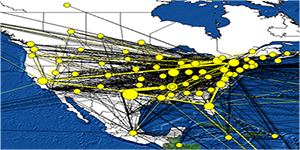New trade agreements, shifting customer and supplier locations, changing labor and freight rates, fuel costs, new products and markets all conspire to make your current logistic network obsolete. Gone are the days when a warehouse distribution network would be reconfigured every ten years or so. Today’s aggressive supply chain executives keep a constant eye on the architecture. Before you can optimize your logistics network model you need to get organized and think about all of the variables that contribute to your costs and service levels. A supply chain logistics network model allows network design to minimize inventory carrying, warehousing, transportation costs while meeting customer lead time and on time requirements. Have too many warehouses? Where to open a new distribution center to serve an emerging market? Distribution Center lease coming up for renewal? Long transit time from low cost country sources worth the inventory carrying and distribution costs?
You need data, a modeling tool, and a plan. Six Steps
- Orientation – define the scope and objectives, key deliverables and milestones
- Variables – document the current state, data sources, interactions, assumptions, and constraints
- Baseline – analyze the sensitivities with paper and software models that mimic the current performance
- Scenarios – what-if alternatives
- Alternatives – evaluate the potential savings, build and test the business case, assess the intangibles
- Implement – it’s all just talk until changes are made: detail then do
*Thanks to Chandrashekar Natarajan and Lee Hales for their book Simplified Systematic Network Planning

One thought on “Logistics Network Model”